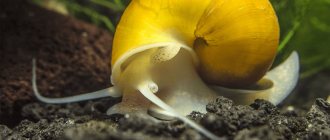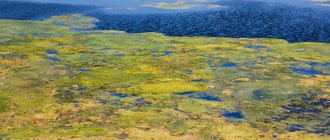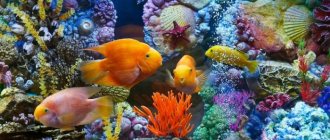Toothless common, or river, is often found at the bottom of reservoirs and lakes where there is running and clean water. Usually snails are located at shallow depths. In sandy ponds you can often spot mother-of-pearl shells. It is very easy to find individuals in nearby reservoirs, rivers or lakes. As a rule, they like to be located close to the shoreline, plunging into the fine sand with the blunt end of their body. Usually only the rear pointed part is visible from the ground.
Toothless is found in bodies of water with running water.
External and internal structure of the toothless
The toothless shell has the shape of an elongated oval; some individuals reach a length of 25 cm. The thickness of the shell is up to 5 cm.
The anterior end of the bivalve shell is rounded, the posterior end is sharp. The walls of the shell are thin and there are no hinge teeth (hence the generic name). The rings of annual growth are clearly visible on the brown-colored valves.
The toothless has no head; the body is located in the upper half of the shell. Leathery folds called the mantle extend from the body, and a mantle cavity is formed between them.
This cavity contains the organs of the mollusk: gills, stomach, intestines, muscular leg.
In the back, pointed part of the shell, you can see siphons: the lower one is inlet and the upper one is outlet. Passing through the lower one, water carrying food particles and oxygen enters the sink. Through the upper siphon, water is removed along with the metabolic products of the mollusk.
The circulatory system is of an open type, blood moves through the vessels of a three-chambered heart.
The internal structure of the common toothless moth is shown in the figure:
Description and characteristics
Toothless belongs to the class of bivalve mollusks that live in fresh water bodies. Its shell does not have hinge teeth, hence its name.
Where does Toothless live?
This mollusk is distributed in Europe, Asia and North America. Its habitat is shallow waters of rivers and lakes with small currents. Along their banks you can often see open mother-of-pearl shells. Live shellfish are also usually found close to the shore, half buried in sand or mud. Loves illuminated areas of the coast.
Kinds
There are over 50 species of toothless in the world.
In Russia, the most common species is the common toothless one, or anodontata cygnea. She lives from the western borders to central Siberia. The length of adult individuals is usually 10 cm, sometimes up to twenty. Inhabits rivers, ponds and lakes. The common toothless fish is extremely variable; even within the same body of water, sometimes such different forms are found that some of them can be classified as new subspecies and even species.
In the European part, the narrow or smooth toothless one is also found. It can live even in desalinated parts of the seas, for example, the Caspian Sea closer to the Volga delta. Its shell has more elongated proportions and can reach 8 cm in length.
In the Caucasus, Primorsky Territory and the Far East, the Caucasian toothless shell is also common. It has a strongly convex shell up to 15 cm long. In the same reservoirs, vaulted toothless fishes, reaching 10 cm, are also found.
In the lower reaches of the Volga, two species of large toothless moths, reaching a size of 25 cm, are now rapidly breeding. Scientists have determined that they are common to China and originate from the Yangtze and Songhua rivers. Most likely, they were introduced along with fish in the 70s, and have proliferated since then. The takeover of our waterways by invasive species poses significant risks to native fauna. They displace other mollusks and insects that are part of the food chain of fish, including commercial fish.
At the same time, in the larval stage, Chinese toothless beetles parasitize fish, reducing their numbers. Already now, in the vicinity of Astrakhan, their share reaches 40% of the total number of all bivalves. And it is no longer possible to remove them from the Volga, since they have become integrated into the river ecosystem.
Toothless's feeding method
This mollusk is a filter feeder.
Phyto- and zooplankton, suspended remains of large organisms pass along with water through the inlet siphon of the mollusk, ending up in the mantle cavity.
The mouth opening, surrounded by folds, located in the front part of the mantle cavity, captures nutrient particles, carrying them further through the digestive system.
The filtered water is discharged through the outlet siphon.
Compatibility
The toothless fish should not be kept in an aquarium with the fish for which it serves as food. Also, toothlessness itself can cause harm. In addition to the fact that it spoils aquarium plants, its parasitic larvae can cause fish illness, as well as the death of young animals or small fish.
To avoid infection of fish with toothless larvae, it is recommended to keep only one individual.
It should be borne in mind that toothless excrement, containing nitrogen and phosphorus, leads to rapid growth of algae. Therefore, you should not have many individuals. Toothless' enemies can be planarian worms. These parasites can be introduced by contaminated soil, plants or live food (bloodworms and other species). Planarians eat toothless larvae and can also enter the gills of adults, causing suffocation.
Moving
The mollusk moves along the substrate with the help of a muscular outgrowth - the leg. The shell opens on the ventral side, revealing a leg through the gap.
With it, the animal pushes off the substrate, leaving characteristic grooves on the bottom of the reservoir. The speed of movement of the mollusk is 20 - 30 cm per hour.
At the moment of danger, the leg quickly retracts and the shell slams shut.
Structure
In appearance, toothless ones are very similar to pearl barleys. Toothless appear slightly larger in size with a thinner shell structure. Their main difference is that in the river pearl barley, the shell valves have teeth on the inside of the dorsal side, forming a lock, which the toothless pearl barley does not have. This is where the name “toothless” comes from. The teeth of the pearl barley can be seen only by opening the shell.
The body of the toothless snail, like that of the grape snail, is covered with a durable shell, which protects the animal from predators. The toothless shell consists of two halves, or valves, tightly adjacent to each other. The shell widens towards the anterior end, and narrows somewhat towards the posterior end. A freshly caught live mollusk has valves that are tightly closed. This is how he defends himself. To open the shell, you need to insert a thin blade between the valves and cut two strong muscles attached to the shell valves at the anterior and posterior ends. By contracting, these muscles close the valves. The shell opens thanks to a strong horn-shaped, elastic ligament running along the dorsal side of the body from the inner surface of one valve to the other. While the toothless is alive, the valves are mostly closed. But when the animal dies, the muscles relax and the shell opens.
Reproduction and development of toothless
Males and females are indistinguishable in appearance. The eggs are fertilized in the mantle cavity, eggs develop there and larvae appear - glochidia, which leave the mother shell through the upper siphon.
The larva, floating in the water, attaches to the skin of the fish, then a tumor forms, in which the toothless development continues.
When the mollusk reaches a certain size, the skin of the fish breaks and the toothless fish falls to the bottom.
Conditions at home
Small aquariums with a significant bottom area are suitable for keeping toothless fish. A low water level promotes better oxygen saturation. In principle, you can even use any other container. Washed sand should be poured onto the bottom in a layer of 5–10 cm. When moving, the mollusks plow the sand quite deeply, so it is better to plant the plants in special pots. It is best to take elodea or hornwort.
Rules for keeping toothless
Toothless is the best natural filter for an aquarium. It purifies water perfectly.
But these mollusks cannot tolerate any chemicals in the water and die instantly from them. A significant amount of dissolved oxygen is also needed, so additional aeration is desirable.
The water temperature should be 20-22C. The water should not be acidic, the best acidity value is 6.8-7.8. Otherwise, rapid destruction of the shell is possible. It is also necessary to maintain water hardness around 10-15 dGH.
The animal's excrement is high in phosphorus and nitrogen, which causes excessive algae growth. Hence, it is not recommended to keep many toothless fish in one aquarium.
With proper care, they can live in an aquarium for more than 2 years. It is necessary to monitor the condition of shellfish. In the event of death, the shell valves open wide.
Economic importance
The economic importance of this species of invertebrates is not so great.
Toothless is used as:
- protein supplement for pet food;
- production of mother-of-pearl buttons;
- aquarium inhabitant.
Toothless animals in nature are much more significant. By filtering water, these mollusks purify it, preventing blooming and stagnation.
Juveniles and larvae of mollusks serve as food for commercial fish. Toothless moths are actively used in environmental studies as a bioindicator species.
Sink
If a piece of toothless shell is dipped into hydrochloric acid, it will hiss and gas bubbles will begin to emerge from it. On the outside, this white calcareous, porcelain layer is covered with a dark, brownish-greenish stratum corneum. The mother-of-pearl layer lining the inside of the toothless shell consists of the thinnest plates overlapping one another. They have a beautiful reflection, shimmering with all the colors of the rainbow. Thus, each door consists of three layers: horn, porcelain and mother-of-pearl.
In summer, the toothless shell grows faster than in winter. Therefore, on its surface one can notice wide summer and narrow winter stripes of annual growth. These stripes can be used to approximately determine the age of the animal.
Breathing and the nervous system
The respiration of the mollusk is carried out by gills. Toothless breathes oxygen dissolved in water, releasing carbon dioxide.
The vital activity of the toothless is regulated by the nervous system, which includes three pairs of nerve ganglia and fibers. The nervous system has no divisions.
BiologyBiology – whole organisms, millions of molecules
One of the great groups of sporozoans is gregarina, which includes up to 500 species. All stinks parasitize on the spineless. Most of them are found in comas, especially in the intestines of arthropods. If the body is empty, the reproductive organs and others will not be lost without their replacement.
Gregarini, who hesitate in the intestines of arthropods, loom the most folding Budov. So we will look at them in action.
Corycella armata has a long body and is divided into 3 sections. The largest branch is the one at the back in which the nucleus is located and is called the deuterite. Protomers are separated before deuterometers and separated with a thin layer of light cytoplasm. The epimer is spread in front, and some gregarine helps to adhere to the intestinal wall. Often they are endowed with hooks, as well as thread-like growths and can be changed into different forms.
Divided the cytoplasm into two spheres (ectoplasm and endoplasm) with very clear expressions. The stable shape of the body of the gregarina is indicated by the external ball of ectoplasm, which creates the mitotic pellicle. Thin skeletal-supporting fibers are constricted in certain grenarines in ectoplasm, which gives greater importance to the external balls of the body. Some gregarines may be able to change the shape of the body, and the stench will disappear on the axes. They contain myofibrils - high-speed fibers that are found in the ectoplasm at the border with the endoplasm.
The endoplasm has a dark gray appearance and is clearly distinguished from the ectoplasm. This is due to the presence of glycogen, which is concentrated in small granules. Intestinal parasites live in the middle and intestines even in small numbers. Therefore, they have to absorb other energies instead of breathing. The anaerobic process has become a substitute for energy. This process is carried out by the division of a glycogen molecule into simple organic substances in which energy is seen.
In the deuterium there are nuclei that look like balls, and there are a couple or one nucleus and there is a lot of nuclear juice there.
We looked at Budova gregarina mainly to intestinal parasites. Family Polycystidae, characterized by such budova. The most common family is Monocystidae, the empty body, plant stems and other organs are the target for the parasitic family. They do not have a hem on the epi-, proto-, deuterite, and have a worm-like shape.
Gregarines are about to collapse in the middle of the intestines. Alas, the stench does not bother any organs of the roc. This fact is not clear to anyone.
Rozmnozhennia goes through the state way. Having reached the singing growth, they spend time and eat in pairs (syzygy). After such a couple, the occipital membrane (cyst) is created. After encystment in the cutaneous syzygy, the rich division of the nucleus begins. Soon a large number of nuclei appear, around which the cytoplasm is formed and reinforced. This is how mononuclear cells are created. The cytoplasm is richly deprived of nevicoristan. These mononuclear cells are gametes - cells. In the process, the stinks get closer to each other and become angry. Gametes in some species have a different size and shape, and in others they are different. Female gametes give rise to indestructible and rounded gametes. Human gametes are fragile and damaged gametes. As a result of the fertilization, the zygote is created and is immediately enclosed by the membrane and excreted as an oocyst. During this period of the development cycle, the lining of the cyst still remains in place. The final stage of development is the formation of the oocyst and the name sporogony. At this stage, the core is divided into three parts. Along with the nuclei there is also a section of cytoplasm. 8 small worm-like cells (sporozoites) emerge from the oocyst. Then gregarine is synthesized from the cutaneous sporozoite. Having formed to a singing size, the gregarines repeat the whole process again. So Gregarin needs to go through three stages. Growth, compaction and formation of sporozoites.
Position in taxonomy (classification)
Toothless is one of the species of the class Bivalves.
On this page there is material on the following topics:
Zrobiti visnovok about the signs of toothlessness
All about toothless and what parts it consists of
What are the structural features of toothless molluscs?
Toothless in brief
Characteristics of the pond snail
Questions about this material:
What are the features of the external structure and movement of the toothless in connection with its habitat?
Where does gas exchange occur in the toothless?
How does the nervous system of the toothless fish differ from the nervous system of the pond snail?
How does toothless reproduce?










